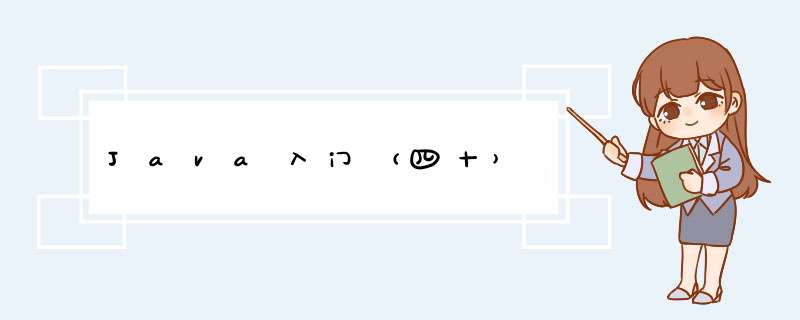
BufferedOutputStream类,该类实现缓冲输出流,通过设置这样的输出六,应用程序可以向底层输出流写入字节。而不必为写入的每个字节导致底层系统的调用。
他可以向FileOutputStream这样的底层输出流写数据,通过一个缓冲区,可以一次性把数据写到文件中。底层调用次数就减少,提高了效率构造方法
和他对应的事BufferedInputStream,他是一个具体类。创建BufferedInputStream将创建一个内部缓冲区数组,当从流中读取或跳过字节时,内部缓冲区需要从所包含的输入流中重新填充,一次很多个字节,也提高了读数据的效率。构造方法
字节缓冲流他们的构造方法
字节缓冲输出流:BufferedOutputStream(OutputStream out) 字节缓冲输入流:BufferedInputStream(InputStream in)
为什么构造方法需要的是字节流,而不是具体的文件或者路径呢?这是因为字节缓冲流仅仅提供缓冲区,而真正读写数据还得依靠基本的字节流对象进行 *** 作。
import java.io.BufferedOutputStream;
import java.io.FileOutputStream;
import java.io.IOException;
public class BufferStreamDemo {
public static void main(String[] args) throws IOException {
//字节缓冲输出流
FileOutputStream fos = new FileOutputStream("Study/src/com/itheima/file/bos.txt");
BufferedOutputStream bos = new BufferedOutputStream(fos);
}
}
其中字节缓冲输出流这两步可以把他合并成一步
BufferedOutputStream bos = new BufferedOutputStream(new FileOutputStream("Study/src/com/itheima/file/bos.txt"));
先来看看他的源码,他用this调用了本类的构造方法,给了8192
- 8192给了这里,我们最后把值给了数组buf
- 然后我们来写数据,写数据要靠底层的输出流去做
BufferedOutputStream bos = new BufferedOutputStream(new FileOutputStream("Study/src/com/itheima/file/bos.txt"));
bos.write("hellon".getBytes());
bos.write("worldn".getBytes());
bos.close();
读数据,首先创建字节缓冲流。
BufferedInputStream bis = new BufferedInputStream(new FileInputStream("/home/ding/IdeaProjects/Study/src/com/itheima_02/file/bos.txt"));
int by;
while((by=bis.read())!=-1){
System.out.print((char)by);
}
bis.close();
来看一下源码,size最后传递给buf数组
- 来看一下buf默认的范围
- 他的值默认大小也是8192,默认也是封装一个8192字节的数组
- 然后我们用另外一种方法来读取数据,一次读取一个字节数组。
byte[] bys = new byte[1024];
int len;
while((len=bis.read(bys))!=-1){
System.out.println(new String(bys,0,len));
}
bis.close();
复制视频
将1.avi复制为2.avi
- 思路:
- 根据数据源创建字节输入流对象根据目的地创建字节输出流对象读写数据,复制视频释放资源
第一种方法,基本字节流一次读写一个字节
import java.io.FileInputStream;
import java.io.FileOutputStream;
import java.io.IOException;
public class CopyAviDemo {
public static void main(String[] args) throws IOException {
//记录开始时间
long startTime = System.currentTimeMillis();
//复制视频
method1();
//记录结束时间
long endTime = System.currentTimeMillis();
System.out.println("共耗时:"+(endTime - startTime) + "毫秒");
}
// /home/ding/IdeaProjects/Study/src/com/itheima_02/file/
//基本字节流一次读写一个字节
public static void method1() throws IOException {
FileInputStream fis = new FileInputStream("/home/ding/IdeaProjects/Study/src/com/itheima_02/file/1.avi");
FileOutputStream fos = new FileOutputStream("/home/ding/IdeaProjects/Study/src/com/itheima_02/file/2.avi");
int by;
while((by=fis.read())!=-1){
fos.write(by);
}
fos.close();
fis.close();
}
}
- 方法2,接本字节流一次读写一个字节数组
import java.io.FileInputStream;
import java.io.FileOutputStream;
import java.io.IOException;
public class CopyAviDemo02 {
public static void main(String[] args) throws IOException{
//记录开始时间
long startTime = System.currentTimeMillis();
//复制视频
method2();
//记录结束时间
long endTime = System.currentTimeMillis();
System.out.println("共耗时:"+(endTime - startTime) + "毫秒");
}
public static void method2() throws IOException {
FileInputStream fis = new FileInputStream("/home/ding/IdeaProjects/Study/src/com/itheima_02/file/1.avi");
FileOutputStream fos = new FileOutputStream("/home/ding/IdeaProjects/Study/src/com/itheima_02/file/3.avi");
byte[] bys = new byte[1024];
int len;
while((len=fis.read(bys))!=-1){
fos.write(bys,0,len);
}
fos.close();
fis.close();
}
}
- 第三种方法,字节缓冲流一次读写一个字节
public static void method3() throws IOException{
BufferedInputStream bis = new BufferedInputStream(new FileInputStream("/home/ding/IdeaProjects/Study/src/com/itheima_02/file/1.avi"));
BufferedOutputStream bos = new BufferedOutputStream(new FileInputStream("/home/ding/IdeaProjects/Study/src/com/itheima_02/file/4.avi"));
int by;
while((by=bis.read())!=-1){
bos.write(by);
}
bos.close();
bis.close();
}
- 第四种方法,字节缓冲流一次读写一个字节数组
public static void method4() throws IOException{
BufferedInputStream bis = new BufferedInputStream(new FileInputStream("/home/ding/IdeaProjects/Study/src/com/itheima_02/file/1.avi"));
BufferedOutputStream bos = new BufferedOutputStream(new FileOutputStream("/home/ding/IdeaProjects/Study/src/com/itheima_02/file/5.avi"));
byte[] bys = new byte[1024];
int len;
while((len=bis.read(bys))!=-1){
bos.write(bys,0,len);
}
bos.close();
bis.close();
}
- 这几种方式耗时不一样。基本字节流一次读写一个字节最慢不要使用。
编码表字符流等于字节流加编码表基础知识:计算机中存储的信息都是用二进制数表示的,我们在屏幕上看到的英文、汉子等自负都是二进制数转换之后的结果。十进制的666对应二进制的001010011010按照某种规则,将字符存储到计算机中,称为编码。反之,将存储在计算机中的二进制数按照某种规则解析显示出来,称为解码。按照A编码解析,这样才能显示正确的文本符号。否则就会导致乱码现象。字符编码:就是一套自然语言的字与二进制数之间的对应规则(A,65)。字符集:是一个系统支持的所有字符的集合,包括各国家文字、标点符号、图形符号、数字等。常见的字符集有ASCII字符集、GBXXX字符集、Unicode字符集等。ASCII 美国信息交换标准代码:是基于拉丁字母的一套电脑编码系统,用于显示现代英语,主要包括控制字符(回车键、退格、换行键等)和可显示字符(英文大小写自负、阿拉伯数字和西文符号)基本的ASCII字符集,使用7位标识一个字符,共128字符。ASCII的扩展字符集使用8位标识一个字符,共256字符,方便支持欧洲常用租房。是一个系统支持的所有字符的集合,包括个国家文字、标点符号、图片符号、数字等。GB2312 :简体中文码表,小于127字符的意义与原来相同,但大于127的字符连在一起时,就表示一个汉字,这样大约可以组合了包含7000多个简体汉字,此外数学符号、罗马希腊的字母、日文的假名都编进去了,连载ASCII里本来就有的数字、标点、字母都统统重新编了两个字节长的编码,这就是常说的“全角”字符,而原来在127号以下的那些就叫半角字符了。GBK:最常用的中文码表。是在GB2312标准基础上的扩展规范,使用了双字节编码方法,共收录了21003个汉字,完全兼容GB2312标准,同时支持繁体汉字和日韩汉字。Unicode字符集:为表达任意语言的任意字符而设计的,是业界的一种标准,也称为统一码、标准万国码。他最多使用4个字节的数字来表达每个字母、符号或者文字。有三种编码方案,UTF-8、UTF-16和UTF32.最常用的位UTF-8编码。UTF-8编码:可以用来表示Unicode标准中任意字符,他是电子邮件、网页及其他存储或传送文字的应用,优先采用的编码。互联网工程工作小组(IETF)要求所有互联网协议都支持UTF-8编码,他使用一至四个字节为每个字符编码。编码规则:128个US-ASCII字符,只需一个字节编码,拉丁文等字符需要两个字节编码。大部分常用字(含中文),使用三个字节编码。其他极少使用的Unicode辅助字符,使用四个字节编码。 字符串中的编码解码问题
编码的方法:使用平台的默认字符集将该String编码为一系列字节,将结果存储到新的字节数组中
byte[] getBytes()
使用指定的字符集将该String编码为一系列字节,将结果存储到新的字节数组中
byte[] getBytes(String charsetName)
解码使用的方法:通过使用平台的默认字符集解码指定的字节数组来构造新的String
String(byte[] bytes)
通过指定的字符集解码指定的字节数组来构造新的String
String(byte[] bytes,String charsetName)
看一下平台默认的字符集输出的是什么
String s = "中国";
byte[] bys = s.getBytes();
System.out.println(Arrays.toString(bys));
上图是采用3个字节表示一个汉字,所以默认字符集是utf-8 。接下来我们用指定编码的方式来做动作。
import java.io.UnsupportedEncodingException;
import java.util.Arrays;
public class StringDemo {
public static void main(String[] args) throws UnsupportedEncodingException {
String s = "中国";
// byte[] bys = s.getBytes();
byte[] bys = s.getBytes("UTF-8");
System.out.println(Arrays.toString(bys));
}
}
使用GBK的话采用两个字节表示一个汉字
byte[] bys = s.getBytes("GBK");
我们做解码,先用带一个参数的构造方法。
String s = "中国";
byte[] bys = s.getBytes();
System.out.println(Arrays.toString(bys));
String ss = new String(bys);
System.out.println(ss);
上面使用了平台默认字符集编码,然后用平台默认字符集解码所以没问题。接下来我们来指定字符集。
String ss = new String(bys,"GBK");字符流中的编码解码问题
字符流抽象基类:Reader 字符输入流的抽象类 ,Writer:字符输出流的抽象类。字符流中和编码解码问题相关的两个类:InputStreamReader ,OutputStreamWrite。InputStreamReader,是从字符流到字节流的桥梁,他读取字节,并使用指定的字符集并把它解码为字符。他使用的字符集可以由名称指定,也可以被明确指定,或者可以接受平台的默认字符集。
OutputStreamWriter ,是从字符流到字节流的桥梁,使用指定的字符集将写入的字符编码为字节,他使用的字符集可以由名称指定或明确指定,又或者可以接收平台默认的字符集。
我们使用这两个构造方法
import java.io.FileOutputStream;
import java.io.IOException;
import java.io.OutputStreamWriter;
public class ConversionStreamDemo {
public static void main(String[] args) throws IOException {
// FileOutputStream fos = new FileOutputStream("基础语法/src/io/osw.txt");
// OutputStreamWriter osw = new OutputStreamWriter(fos);
OutputStreamWriter osw = new OutputStreamWriter(new FileOutputStream("基础语法/src/io/osw.txt"));
osw.write("中国");
osw.close();
}
}
OutputStreamWriter osw = new OutputStreamWriter(new FileOutputStream("基础语法/src/io/osw.txt"),"GBK");
虽然我们读不懂GBK乱码,但是可以通过InputStreamReader来读懂。他只要按照字符编码GBK来读就能读懂。而他的构造方法
字符流读数据有两种方法:一次读取一个数据,一次读取一个字符数组的数据。这里我们采用GBK来写,通过默认字符编码读取。所以这样读取会有问题
InputStreamReader isr = new InputStreamReader(new FileInputStream("基础语法/src/io/osw.txt"));
int ch;
while ((ch=isr.read())!=-1){
System.out.println((char)ch);
}
isr.close();
所以要指定GBK的方法来读取数据
InputStreamReader isr = new InputStreamReader(new FileInputStream("基础语法/src/io/osw.txt"), "GBK");
字符流写数据的5种方式
字符流写数据并不能直接写数据到文件里面来,因为他最终要通过字节流来写的。所以他还在缓冲区里面。如何让数据直接进入文件里面来呢?要用刷新流。
import java.io.FileOutputStream;
import java.io.IOException;
import java.io.OutputStreamWriter;
public class OutputStreamWriterDemo {
public static void main(String[] args) throws IOException {
OutputStreamWriter osw = new OutputStreamWriter(new FileOutputStream("基础语法/src/io/osw2.txt"));
osw.write(97);
osw.flush();
}
}
在close() 释放资源之前,会做一次flush。写入一个字符数组
char[] chs = {'a','b','c','d','e'};
osw.write(chs);
osw.close();
写入索引位置开始的字符
osw.write(chs,0,chs.length);
一次写一个字符串
osw.write("abcdefg");
osw.write("abcde",0,"abcde".length());
字符流读数据的2中方式
一次读一个字符数据
import java.io.FileInputStream;
import java.io.IOException;
import java.io.InputStreamReader;
public class InputStreamReaderDemo {
public static void main(String[] args) throws IOException {
InputStreamReader isr = new InputStreamReader(new FileInputStream("基础语法/src/io/osw.txt"));
int ch;
while((ch=isr.read())!=-1){
System.out.print((char)ch);
}
isr.close();
}
}
一次读一个字符数组
char[] chs = new char[1024];
int len;
while((len=isr.read(chs))!=-1){
System.out.print(new String(chs,0,len));
}
复制java文件
把ConversionStreamDemo.java复制到Copy.demo。思路:
- 根据数据源创建字符输入流对象根据目的地创建字符输出流对象读写数据、复制文件释放资源
import java.io.*;
public class CopyJavaDemo01 {
public static void main(String[] args) throws IOException {
InputStreamReader isr = new InputStreamReader(new FileInputStream("基础语法/src/io/ConversionStreamDemo.java"));
OutputStreamWriter osw = new OutputStreamWriter(new FileOutputStream("基础语法/src/io/CopyJava.java"));
int ch;
while((ch=isr.read())!=-1){
osw.write(ch);
}
osw.close();
isr.close();
}
}
import java.io.*;
public class CopyJavaDemo01 {
public static void main(String[] args) throws IOException {
InputStreamReader isr = new InputStreamReader(new FileInputStream("基础语法/src/io/ConversionStreamDemo.java"));
OutputStreamWriter osw = new OutputStreamWriter(new FileOutputStream("基础语法/src/io/CopyJava.java"));
char[] chs = new char[1024];
int len;
while((len=isr.read(chs))!=-1){
osw.write(chs,0,len);
}
osw.close();
isr.close();
}
}
欢迎分享,转载请注明来源:内存溢出

 微信扫一扫
微信扫一扫
 支付宝扫一扫
支付宝扫一扫
评论列表(0条)